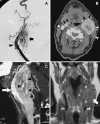Head and neck pathology-radiology classics: vagal paraganglioma
- PMID: 20614279
- PMCID: PMC2807509
- DOI: 10.1007/s12105-007-0018-1
Head and neck pathology-radiology classics: vagal paraganglioma
Figures



References
-
- Hunt JL. Diseases of the paraganglia system. In: Thompson LDR, editors. Head and Neck Pathology (A volume in the fundation in diagnostic pathology series ed. Goldblum JR) Elsevier, Philadelhia, PA 2006: 551–62.
-
- Barnes L, Tse LLY, Hunt JL. Carotid body paraganglioma. In: Barnes EL, Evenson JW, Reichardt P, Sidransky D, editors. Pathology and genetics of head and neck tumours. Lyon, France: IARC Press; 2005. pp. 364–365.
-
- Rao AB, Koeller KK, Adair CF. From the archives of the AFIP: Paragangliomas of the head and neck: radiologic-pathologic correlation. Radiographics. 1999;19:1605–32. - PubMed
-
- Olsen WL, Dillon WP, Kelly WM, Norman D, Brant-Zawadzki M, Newton TH. MR imaging of paragangliomas. AJR Am J Roentgenol. 1987;148(1):201–4. - PubMed
MeSH terms
LinkOut - more resources
Full Text Sources

